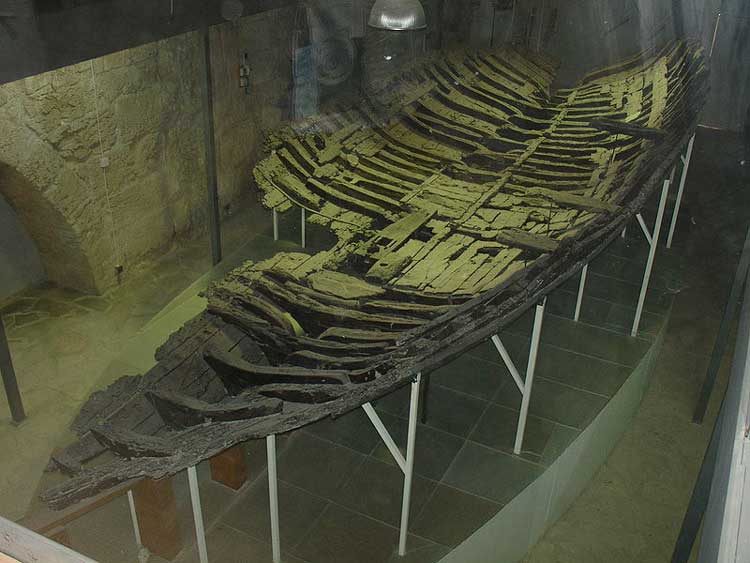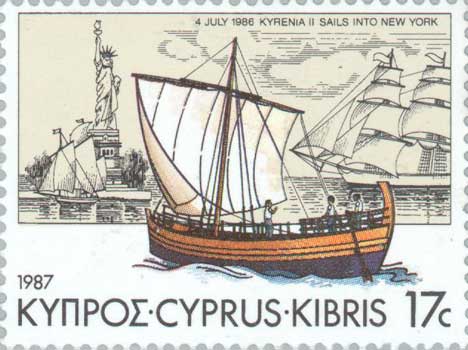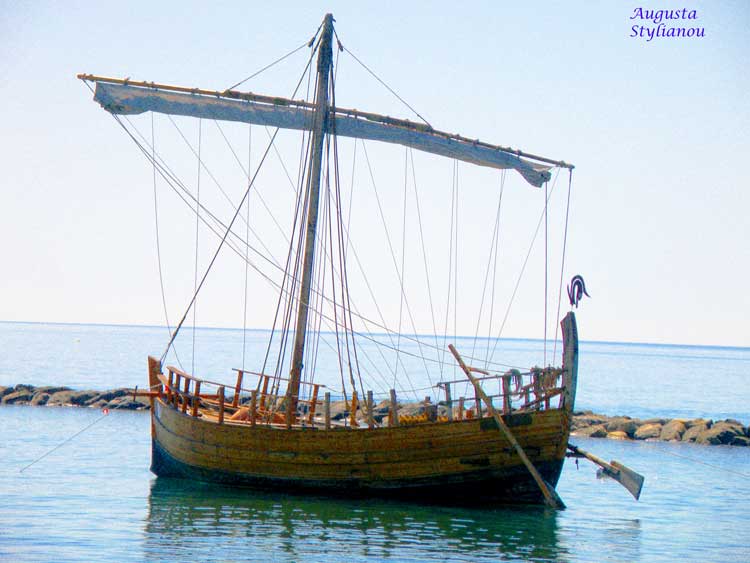.


Kyrenia ship (*)
The Kyrenia ship is the wreck of a 4th century BC Greek merchant ship. It was discovered by Greek-Cypriot sponge diver Andreas Kariolou in 1967 and salvaged close to Kyrenia in Cyprus in an expedition directed by Michael Katzev, a graduate student at the University of Pennsylvania's University Museum, from 1967-69. Preservation of the ship's timbers continued during the winter of 1970. Katzev later was a co-founder of the Institute of Nautical Archaeology. The find was extensively covered in a documentary by the National Geographic Society. It is the only preserved ship from Greece's Classical Age. The ship was considered to be very well preserved with approximately 75% of it in good condition. It found a new home at the Ancient Shipwreck Museum in Kyrenia Castle.In 1974 Kyrenia, and the rest of Northern Cyprus, was occupied by Turkey. The ship remained in the city and is still preserved.
The ship sailed in the Mediterranean during the life time of Alexander the Great and his successors. She sank in open waters less than a mile from the anchorage of Kyrenia. The evidence point to her being taken by rough seas around the year 300 BC, when she was rather old, though piracy is becoming more likely[1].
In 1974 Kyrenia, and the rest of Northern Cyprus, was occupied by Turkey. The ship remained in the city and is still preserved.
The Sinking
The sinking of the Kyrenia could have been caused by many factors, but evidence suggests that piracy and old age could have all contriubted to the ship’s fate.
In observing the ship, excavators found spear points among the hull[1]. While these could very well be used for the protection of the crew, rubber casts indicate that they were in contact with the lead sheathing covering the ship[1]. This would suggest that the points were stuck inside the hull when it sank- possible evidence of an attack[1]. In typical merchant ships, the captain would have a balance, weights, and coinage for measuring and trading goods- all of which were missing[1]. Even more surprising is that over a ton of cargo is absent from the wreckage[1]. This leads researchers to believe that the ship must have been plundered at some point. What opens up this argument further is the presence of a curse tablet among the wreckage[1]. A pirate, for example, would hammer the lead tablet to a part of the boat as it sank in hopes that the dark magic it evoked would conceal the evidence of their crime[1]. These facts, when looked at together, lead many to believe that piracy played a part in the sinking of the Kyrenia.
The ship was in use by merchants for 15-25 years[1]. Knowing that the ship was old, archaeologists could use the repairs on the Kyrenia to better understand classical carpentry. The hull’s age increased the need for the defense against water loss, so any repairs would give very specific evidence to the problems facing ancient ships. A break in the ship’s keel was fixed, and the outside of the ship was protected with pitch and lead sheathing[2]. These measures were taken to extend the ship’s lifespan. Closer analysis of the rabbets in the hull’s frame suggest that the mast step had been moved up to three, and possibly four times[2]. This movement happens to be in close proximity with a well to collect bilge water[3][2]. Because of this, archaeologists surmise that the movement of the mast step was to make way for a larger bilge pump, capable of dealing with the greater needs of the aging ship[4]. The extreme measures to deal with water loss corroborate the frailty of this ship, which very likely contributed to the ship’s sinking.
All these factors could have worked together to cause the sinking of the Kyrenia. The definitive answer cannot be known completely, but the ship is still important to scholars. The hull’s near-complete preservation, along with the extent of its reconstruction, adds to the basis of knowledge concerning ship building in antiquity.
Kyrenia II

Kyrenia II, Reconstruktion of an ancient ship found near Kyrenia (1986 in the Harbour of New York)
In 1985, Greek professors completed a full-size replica of the ship, known as Kyrenia II. Kyrenia II is often used as a floating ambassador of Cypriot culture, and has visited many parts of the world. In 1986, it visited New York, in 1988, Japan, in 1989 West Germany.
Kyrenia III
Following the 1988 visit to Japan, the Japanese city of Fukuoka constructed a second copy of the ship which is on permanent display in the city.
Kyrenia Liberty

Kyrenia Ship Replica in the Limassol Area, Photo : Augusta Stylianou Artist
In 2002, the construction of a third replica of the ship began. The ship was named Kyrenia Liberty. It was built with respect for the original design but with modern techniques. The ship was ready for the 2004 Olympic Games and set sail for Athens, Greece with a symbolic cargo of copper to be used in the Olympic bronze medals. This cargo was symbolic since the name Cyprus is associated with the Greek word for "copper".
Symbolism of the Kyrenia ships
The Kyrenia ship, Kyrenia II, and Kyrenia Liberty have become symbols of national pride for many Cypriots and a symbol of their lost home town for many Greek-Cypriot refugees from Kyrenia.
The Kyrenia ship features on three of the Cypriot euro coins, the 10, 20, and 50 cents.
Discovery
Michael Katzev of the University Museum of Pennsylvania directed a team to survey the coast of Cyprus for shipwrecks in 1967. In Kyrenia a sponge diver took the team to the site. Using a metal detector, protonmagnetometer and probes, the group spent a month surveying the site to find the ship and the cargo over an area measuring 60 x 30 feet (9.1 m). During the summers of 1968 and 1969 the expedition consisting of 50 under water archaeologists, students and technicians employed stereo-photography and other developed techniques to record the position of each object before they were raised. Then the ship's wooden hull which was well preserved in the sand mud was "mapped" labelled and lifted in pieces to the surface.
Findings
The objects in Kyrenia Castle are the original ones carried on her during her last voyage about 2300 years ago. From them we can learn about the life of those traders. More than 400 wine amphoras, mostly made in Rhodes, consist the main cargo, and they indicate that the ship made an important stop at that island.
On the other hand, ten distinct amphora shapes on boar show a different port of call, such as Samos in the north. Another part of the cargo of the ship was perfectly preserved almonds, 9000 in number, which were found in jars and also amassed within the ship's hull. The 29 millstones, laden on over the keel in three rows, were being transported as cargo, but at the same time serving as ballast. At the stone quarry, probably on the island of Kos, masons carved letters of indentification on the sides of these stones. From all these it can be assumed that the ship sailed southwards along the coast of Anatolia, calling at Samos, Kos and Rhodes before continuing eastwards to her destruction in Cyprus.
That the sailors fished during the voyage is clear from more than 300 lead net weights left in the bow. Meals were probably prepared ashore, using large casserole pot and a bronze cauldrons.
Four wooden spoons, four oil jugs, four salt dishes and four drinking cups recovered in the shipwreck suggest the number of the crew on the last voyage. The ship's single sail had been taken down before sinking since in the stern were found more than 100 lead rigging rings from a large square sail stowed there. The wooden hull, built mostly of Aleppo pine, was preserved for a length of almost 40 feet (12 m), originally measured 47 feet (14 m) long by 14 1/2 across. The ship was built in the "shelfirst" manner, quite the opposite of today's method. Rather than building a skeleton of ribs first, her outer planking up from the keel was constructed and then the ribs were laid in and these were secured with copper spikes. The ship was intended for long service and underwent many repairs. In the last reparation a skin of lead sheathing was applied to her body to keep the old ship waterproof. Carbon 14 analysis of the almonds points to a date of 288 (plus or minus 62) B.C. and the tees out for the ship planking 389 (plus or minus 44) B.C. Hence, the ship was more than 80 years old the day she sank.
Preservation and conservation of the ship began in 1970 and lasted four years. It was interrupted by the Turkish Invasion in Cyprus in 1974.
Museum
The Ancient Shipwreck Museum is located in Kyrenia, Northern Cyprus, and is home to an old trading ship, along with its cargo, which sailed the Mediterranean Sea during the time of Alexander the Great. The vessel and cargo were raised from the bed of the ocean, and now form a historical exhibit at the museum.
An exhibit of cargo, as well as the wreck itself are on display at the museum. Amongst the exhibit items that can be found in the museum are over four hundred wine amphoras from Rhodes. Also amongst the items that were recovered from the wreck are wooden spoons, jugs, salt dishes, and drinking cups, and these give an indication of the number of crew members that were aboard the vessel when it sank. Also recovered were jars filled with nine thousand preserved almonds.
It is thought that the ship was around eighty years old when she sank over two thousand years ago. A number of contributions made in the 1970s enabled the preservation and conservation of the vessel, which was started in 1970 and went on for four years.
Information about the Ancient Greek Merchant Ship of Kyrenia , Model of the Kyrenia Merchant Ship , Images from the construction
See also
- Ships of the World. Kyrenia ship
- Ships of the World. Kyrenia II
- A (Greek-)Cypriot page about the Kyrenia ship
- The Central Bank of Cyprus - regarding the design of Cypriot euro coins
|
Archaeological sites , ancient cities in Cyprus Aetokremnos | Alassa | Apliki | Choirokoitia | Chytri | Gialia Monastery | Enkomi | Kalavasos-Tenta | Kastros | Katalymata ton Plakoton | Klimonas | Kourion | Kyrenia ship | Lapithos | Marion | Marki Alonia | Mnemata Site | Paphos | Salamis | Shillourokambos | Soli | Tamassos | Tombs of the Kings (Paphos) | |
| Ancient Greece
Science, Technology , Medicine , Warfare, , Biographies , Life , Cities/Places/Maps , Arts , Literature , Philosophy ,Olympics, Mythology , History , Images Medieval Greece / Byzantine Empire Science, Technology, Arts, , Warfare , Literature, Biographies, Icons, History Modern Greece Cities, Islands, Regions, Fauna/Flora ,Biographies , History , Warfare, Science/Technology, Literature, Music , Arts , Film/Actors , Sport , Fashion --- |
